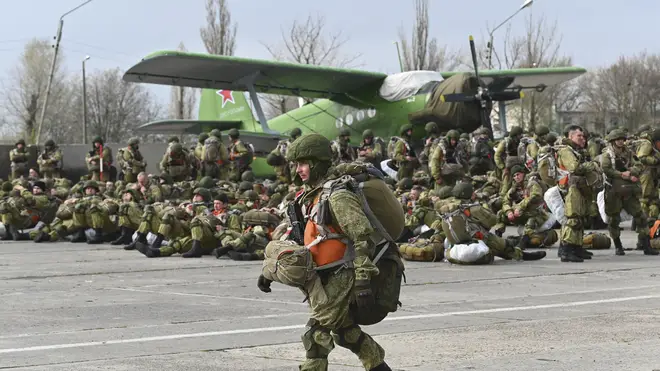
Richard Spurr 1am - 4am
22 April 2021, 16:04

The move came after massive drills in Crimea that involved dozens of navy ships, hundreds of warplanes and thousands of troops.
Russia’s defence minister has ordered troops back to their permanent bases following massive drills in Crimea that involved dozens of navy ships, hundreds of warplanes and thousands of troops in a show of force amid tensions with Ukraine.
Ukrainian President Volodymyr Zelenskyy welcomed the Russian pullback.
After watching the drills, Russian defence minister Sergei Shoigu declared the manoeuvres over and ordered the military to pull the troops taking part in manoeuvres in Crimea and western Russia back to their permanent bases.
“I consider the goals of the snap check of readiness fulfilled,” Mr Shoigu said.

“The troops have shown their defence capability and I decided to complete the drills in the south and western military districts.”
He said the troops should return to their bases by May 1, but he also ordered keeping the heavy weapons deployed to western Russia as part of the drills for another massive military exercise later this year.
Mr Shoigu said they should remain at the Pogonovo firing range in the south-western Voronezh region.
The sprawling range is located 160 kilometres (about 100 miles) east of the border with Ukraine.
The Russian troop build-up near Ukraine that came amid increasing violations of a ceasefire in Ukraine’s east has raised concerns in the West, which urged the Kremlin to pull its forces back.
The US and Nato have said that the Russian build-up near Ukraine was the largest since 2014, when Russia annexed Crimea and threw its support behind separatists in Ukraine’s eastern industrial heartland called Donbas.
Ukraine’s president said the Russian troops’ pullback will help ease tensions and thanked international partners for their support.

“The reduction of troops on our border proportionally reduces tension,” Mr Zelenskyy said on Twitter.
He noted that Ukraine remains vigilant, but “welcomes any steps to decrease the military presence and deescalate the situation in Donbas”.
The Russian military has not reported the number of additional troops that have been moved to Crimea and parts of south-western Russia near Ukraine, and it was not immediately clear from Mr Shoigu’s statement if all of them will now be pulled back.
The Russian Defence Ministry said the manoeuvres in Crimea involved more than 60 ships, over 10,000 troops, around 200 aircraft and about 1,200 military vehicles.
The exercise featured the landing of more than 2,000 paratroopers and 60 military vehicles on Thursday.

Fighter jets covered the airborne operation.
Mr Shoigu flew in a helicopter over the Opuk firing range in Crimea to oversee the exercise.
He later declared the drills over, but ordered the military to stand ready to respond to any “adverse developments” during Nato’s Defender Europe 2021 exercise.
The Nato drills began in March and are to last until June.
“Nato has significantly intensified its military activities in the region,” Mr Shoigu said.
“Intelligence gathering has increased and the intensity and scope of operational training has been growing. One of the alliance’s main coalition groups is being deployed in the Black Sea region.”
Russia has long bristled at the deployment of Nato’s forces near its borders and stepped up its drills as relations with the West have sunk to post-Cold War lows over the annexation of Crimea, Russian meddling in elections, hacking attacks and other issues.
Last week, Russia announced that it would close broad areas of the Black Sea near Crimea to foreign navy ships and state vessels until November, a move that drew Ukrainian protests and raised Western concerns.

Russia also announced restrictions on flights near Crimea this week, arguing that they fully conform with the international law.
Ukrainian foreign minister Dmytro Kuleba warned on Tuesday that the Russian build-up across the border is continuing and is “expected to reach a combined force of over 120,000 troops” in about a week and urged the West to beef up sanctions against Moscow.
Moscow has rejected Ukrainian and Western concerns about the build-up, arguing that it is free to deploy its forces anywhere on the Russian territory and claiming that they do not threaten anyone.
But at the same time, the Kremlin sternly warned Ukrainian authorities against trying to use force to retake control of the rebel east, where seven years of fighting have killed more than 14,000 people, saying that Russia could be forced to intervene to protect civilians in the region.
Amid the tensions, Ukraine’s president on Wednesday signed a law allowing the call-up of reservists for military service without announcing a mobilisation.
The new law will allow for quickly equipping the military with reservists, “significantly increasing their combat effectiveness during military aggression”, Mr Zelenskyy’s office said in a statement.